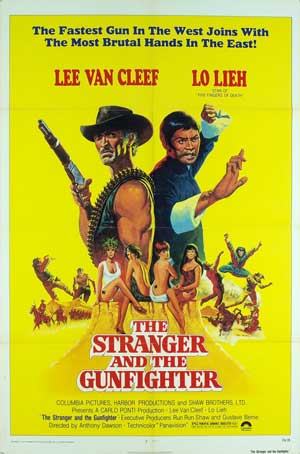
In last week’s ENTER THE FIST column I mentioned that the period between Bruce Lee’s death and the eventual rise of Jackie Chan was a confusing one for martial arts cinema. With the one-two punch of FIVE FINGERS OF DEATH and ENTER THE DRAGON, the United States was ravenous for kung-fu, but without an English speaking star to anchor the films, it was seen increasingly as a niche genre. The resulting void was huge, and out of desperation (and opportunism) attempts were made to meld kung-fu with other popular genres in order to create a unique hybrid that could be easier to market. Golden Harvest co-produced the James Bond-influenced THE MAN FROM HONG KONG (with Jimmy Wang Yu and directed by Brian Trenchard-Smith) in Australia, while The Shaw Brothers matched martial arts with Hammer horror in THE LEGEND OF THE 7 GOLDEN VAMPIRES (with David Chiang and Peter Cushing).
But perhaps the strangest melding – though one with surprising legs – is the pairing of martial arts and the American western. While a film like SHANGHAI NOON can find mainstream success in modern cinemas, the concept must have seemed really out there in 1971 when the film RED SUN matched legendary Japanese samurai performer Toshiro Mifune with French actor Alain Deloin and Swiss sexpot Ursula Andress for a western shot in Spain by British director Terence Young. Whew! And Charles Bronson was in it, too! But, of course, that was trading more on the popularity of the Akira Kurosawa samurai films, and the uniqueness of the international cast. And of course, Japanese cinema had already been mined for inspiration for THE MAGNIFICENT SEVEN (a retelling of THE SEVEN SAMURAI) and A FISTFUL OF DOLLARS (which re-imagines YOJIMBO), so pairing up the themes and actors made a certain amount of sense.
But would the pairing up of themes and actors work as well in a kung-fu western? While American studios – who had already abandoned making westerns by the 70s – showed little interest, the burgeoning Italian “Spaghetti Westerns” were more experimental. There had even been a pre-RED SUN attempt to meld samurai with cowboys in THE SILENT STRANGER (1968) In fact, even before THE STRANGER AND THE GUNFIGHTER there was MY NAME IS SHANGHAI JOE (aka THE FIGHTING FISTS OF SHANGHAI JOE) (1973) directed by the prolific Mario Caiano and starring the little known Chen Lee as Shanghai Joe, and featuring Klaus Kinski in a supporting role. While far from a complete success, the film showed that with a little effort the genres could be successfully melded (and it even spawned a sequel, RETURN OF SHANGHAI JOE, in 1974).
But the first serious post-Bruce Lee attempt to match East and West was 1974’s THE STRANGER AND THE GUNFIGHTER (aka BLOOD MONEY) which would pair Western stalwart (and Sergio Leone vet) Lee Van Cleef with FIVE FINGERS OF DEATH (aka KING BOXER) kung-fu superstar Lo Lieh. The film would be co-produced by the Shaw Brothers; filmed in both Hong Kong and Spain, and – eventually – even find North American distribution through Columbia Pictures. Yep, a spaghetti western featuring Lo Lieh played in American theaters. And that’s why the 70s were an amazing time for film-lovers.

Van Cleef plays Dakota – a thief with a heart of gold – who we see breaking into a bank and attempting to crack a safe. Van Cleef is playing the lovable rogue here as opposed to a steel-faced killer, since this is a post THEY CALL ME TRINITY spaghetti western and most of the events are played for laughs. The safe door springs open to reveal.. a photo! Of an ass! Your confusion is quickly replaced with MORE confusion as flashbacks reveal that the ass belongs to one of a series of mistresses/prostitutes who all received tattoos on their bums which – when put together – reveals some sort of secret message. The tattooist was the diminutive Wang, who was sent from China to invest money into American businesses. When Wang spies Dakota trying to blow the safe, he runs down to stop him – but ends up getting blown up by the dynamite. Idiot. Just then, the Sheriff stops by and tells Dakota that he’s under arrest and headed for the gallows. And that someone needs to find Wang’s heir! WHO COULD THAT BE?
Why, it’s Ho Chiang (Lo Lieh), a humble kung-fu student who is accosted at his temple (the nerve!) and forced in front of the warlord who demands he tell him what happened to the gold he sent to America with (his Uncle) Wang. Threatening to murder his parents, and throw his sister to the guards (the fiend!), Ho Chiang decides to show his worth by easily beating the hell out of everyone that surrounds him. This would normally be a highlight, but the action in the film is edited choppily, and Lo Lieh’s impressive skills are often accompanied by the sound of a slide-whistle(!). Even worse is the soundtrack (by the usually reliable Carlo Savina) which switches from execrable jazzy pop to inappropriate funk at random intervals. Eventually the warlord agrees to give Ho Chiang one year to travel to America and track down what happened to the gold. HE ALSO REFERENCES A WOODEN INDIAN STATUE THAT WANG HAD SENT HIM. I can’t imagine that might be important.
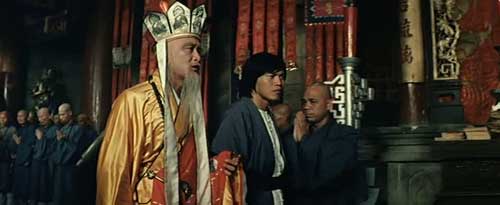
So Chiang is OFF TO AMERICA! And his lawyer informs him that his Uncle left only a thousand dollars, the series of photos (with names and addresses scrawled on the back) and a cookie as his inheritance. He’s also told that Dakota – who is waiting to be hanged in a nearby jail – was the one who tried to steal the photos from the bank. Ho Chiang wants to talk to Dakota, but thinks if he reveals who he is that he’ll be dismissed. So, what does he do? He gets himself arrested! First by taking a dog into a bar with a NO NEGROES NO CHINESE OR UNACCOMPANIED DOGS ALLOWED sign (the scamp!), and then kicking the sheriff in the face once they try to throw him out.
Margheriti smartly skips the “getting to know you” business, and soon Dakota has convinced Chiang that he never meant to hurt his Uncle, and that he doesn’t know anything about the photos. Chiang breaks open the cookie to discover a message – in Chinese – that states “At bottom of every woman is a fortune”. This leads to the CLASSIC piece of dialogue:
Ho Chiang: “What mean bottom?”
Dakota: “Bottom? ASS!”
And the next day Dakota is hanged by his neck until he’s dead. Wait. No. Instead Ho Chiang uses his throwing knives to cut the ropes and the two ride off to have adventures together. But not before we get wacky “comedy” scenes of Ho Chiang feeding Dakota some roasted snake, Chinese tea and Chinese liquor (which Dakota spits onto the fire, turning it into a roaring inferno). To the film’s credit, while it certainly wallows in stereotypes, it also presents Ho Chiang as the most intelligent and capable character in the film. He’s not Dakota’s sidekick, he’s really the driving force of the action in the entire film. And Lo Lieh – who, like many of the actors, is dubbed by someone else here – gives a fine performance, even if he’s not always given much interesting to do.
So, the two decide to track down the four women on the photos, starting with an American woman who is the current beau of notable crazy person Yancey Hobbitt (Julián Ugarte), a former soldier-turned-preacher who looks like a mixture of El Topo and Serpico. He travels in a rather impressive stagecoach that has a church built on to it, and murders “sinners” without hesitation. Ho Chiang, who doesn’t seem to be intimidated by anyone, is convinced the best way to approach this problem is to simply ask about “his woman’s ass”. Dakota is hesitant, but eventually the two break in and hold Yancey hostage while they pick the lock of his companion’s chastity belt (“My interest is purely scientific.”) and make note of her ass tattoo. Our two heroes leave, but Yancey – who has heard about Wang’s treasure – figures out their plan, and decides he’s going to get to it first
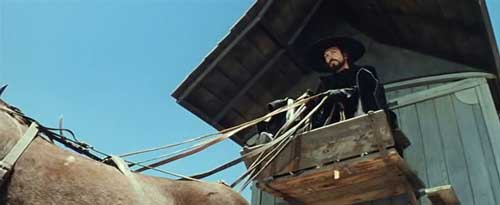
The two head down to Mexico (apparently) where the next gal is to be the wife of a saloon/gambling house owner. Faced with the difficulty of checking out the owner’s wife’s ass, Ho Chiang devises a plan. Using ANCIENT CHINESE MATHMATICS (aka an abacus) combined with measuring surrounding factors (temperature, the amount the roulette wheel is being illegally manipulated) he quickly starts racking up money. Once he starts bankrupting the house, the owner is called down to put a stop to things – taking away Chiang’s abacus, forcing him to use the surrounding jewelry as a way to cleverly work out the winning number. Dakota, overjoyed at their luck, joins Chiang as the pair head to the owner’s office to try and work out a deal. Of course, the owner can’t afford to pay, so they work out a deal (much to Dakota’s chagrin) that instead of taking the $100,000 they’ll just take a gander at his wife’s ass. He reluctantly agrees, but they discover the wife has NOTHING on her butt! They discover the real ass belongs to her twin sister, who is a prostitute in the bar(!) and would readily show her ass for $10. Yeah, they gave up $100,000 for nothing. They check out the sister who readily shows her signature covered ass (“Resembles guest book at Peking palace.”) and the two are soon riding off to the next butt.
Next up is the wife of Gordon Barclay, a ditzy old British millionaire who lives on a steam train. Mistaking Ho Chiang and Dakota for doctors hired to attend to his wife’s sciatica. Chiang uses the ancient art of acupuncture to heal her in – literally – seconds, and copies her ass tattoo in the process. The pair leave, with Yancey (and his burly Indian thug) soon arriving to beat up the millionaire and force his wife to show her behind (“Those two sinners got here first as usual”).
We’re in the home stretch! You might have noticed that despite ostensibly being a kung-fu western, there has been very little fighting OR shooting. The film’s light tone precludes too much cold-blooded murder, though it doesn’t excuse the almost complete lack of action in these middle sequences. That said, it’s all fun and – generally – amusing stuff, even if it’s awfully corny.
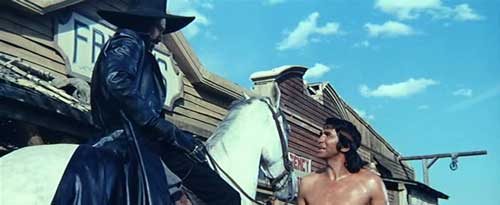
The final town is one that Dakota is intimately familiar with, having spent $2000 on whores and whiskey a few years back. While Dakota lives it up, Ho Chiang visits with the owner of the local Chinese laundromat and his daughter Lia Hua, who is the final ass he’s looking for. Of course, he quickly falls for her, and is unable to transition into asking for her to drop her pants. Visiting Dakota (who is dancing and singing in the bar!), he admits his failure just as Yancey and a gang of men (led by the villainous Calico) kidnap Lia Hua and set the laundromat on fire. There’s a brief gunfight, before the gang rides off and Dakota and Ho Chiang pull the laundromat owner out of the fire – giving him just enough time to ask Ho Chiang to bring his (American born) daughter to China before he dies. The stranger and the gunfighter decide to head to Calico’s hideout (in an abandoned mission) and end this thing once and for all.
Outside the mission, Ho Chiang pays Dakota his portion of the reward and asks him to leave, knowing the path ahead is too dangerous. Dakota refuses (“I might be a thief. I may have spent more time in jail than a prison guard. But nobody can accuse me of running out on a friend”), though he might have regretted his decision when – minutes later – he’s captured by Calico and horse-whipped. Ho Chiang sneaks into the mission, beating up a few guards and breaking into a stable that Dakota is in the process of breaking out of (“Dakota! Son of lady who gives favor for profit!” “Son of a bitch is quicker”). Meanwhile, Yancey has Lia Hua in a cage with a fire lit underneath, her feet starting to burn as the temperature on the metal rises. Unable to read Chinese, she can’t help them translate the text, which just seems to make them angrier.

SO a shirtless Lee Van Cleef mounts a machine gun between two horses and creates a distraction by MOWING DOWN dozens of Calico’s men. Ho Chiang makes good use of Yancey’s confusion by sneaking into their hideout and releasing Lia Hua, before being joined by Dakota who does a classic Leone stare-down (only not as good) with Yancey, who tosses his pistol aside. This leads to a fight – finally – between the Indian thug and Ho Chiang, which is terribly choreographed but does let Lo Lieh have a few fun David vs Goliath moments. He eventually pierces the baddie with his fists and watches as he tumbles off a staircase to his death. The cowardly Yancey tries to reach for his gun in the resulting distraction, but but Dakota shoots him full of holes. At least that was satisfying.
Back in China, the Warlord is a bit peeved. Ho Chiang has returned without his promised fortune, and as a result is going to be decapitated. He, of course, fights his way away from the guards before breaking open the wooden indian statute (hey! It IS important!) and revealing a collection of shares in a variety of American companies – the value of which is many times the original fortune! The warlord is happy, Ho Chiang is happy – since his parents will no longer be killed, and his sister won’t be sold into sexual slavery, Lia Hua is happy – since she’s in China with Ho Chiang, despite apparently being unable to read or understand Chinese, and Dakota is happy – since now he’s in China too! Yes, the enduring image of the film is Lee Van Cleef dressed in ridiculous clothes as he demands to be shown around China. Without a doubt, this is THE END.
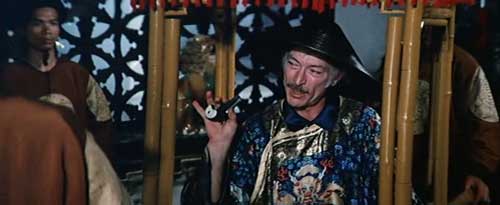
Unsurprisingly, THE STRANGER AND THE GUNFIGHTER didn’t lead to a string of East meets West martial arts westerns, though it remains a sporadically entertaining and enjoyable mish-mash of influences. Those hoping for plenty of action might leave disappointed, but as a light, consistently silly western diversion with a few fun twists, it certainly does the job. Van Cleef and Lo Lieh have some amusing chemistry, and it looks quite good – a step above the production values of many of the spaghetti westerns of this period. There’s also plenty of beautiful women onscreen – many of which (like Patty Shepard and Femi Benussi) are veterans of Italian western and gialli.
The melding of kung-fu and western wouldn’t really find smash commercial success until the release of SHANGHAI NOON (with Jackie Chan and Owen Wilson) in 2000, though both American and Italian westerns would have some influence on the feel of some later martial arts films – like the ONCE UPON A TIME IN CHINA series. THE STRANGER AND THE GUNFIGHTER makes for a fascinating curio, but unless you’re a big fan of westerns or Lo Lieh, it’s probably not worth your time.
NEXT WEEK: THE GAME OF DEATH (1978)
Long live the fist,
Sweetback
- [THE BIG QUESTION] WHAT’S YOUR FAVORITE FEMALE ENSEMBLE IN MOVIES? - July 22, 2016
- [IN THEATERS NOW] THE BOY (2016) - January 24, 2016
- Cult Movie Mania Releases Lucio Fulci Limited Edition VHS Sets - January 5, 2016





No Comments